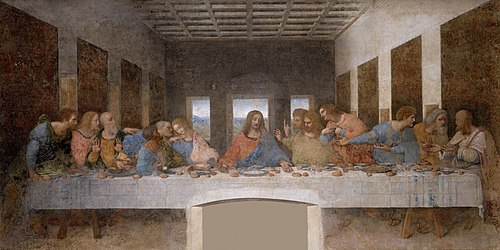Cène/The Last Supper 最後的晚餐,基督教會中常見(名作十來幅),以達文奇的同名作品( Leonardo da Vinci's late-1490s mural painting in Milan)著名--它的1980年代大修復. Now I Lay Me Down to Eat: Notes and Footnotes on the Lost Art of Living
https://www.facebook.com/hanching.chung/videos/397962481713971

The Last Supper is the final meal that, in the Gospel accounts, Jesus shared with his apostles in Jerusalem before his crucifixion.[2] The Last Supper is commemorated by Christians especially on Maundy Thursday.[3] The Last Supper provides the scriptural basis for the Eucharist, also known as "Holy Communion" or "The Lord's Supper".[4]
The First Epistle to the Corinthians contains the earliest known mention of the Last Supper. The four canonical gospels state that the Last Supper took place in the week of Passover, days after Jesus's triumphal entry into Jerusalem, and shortly before Jesus was crucified that week.[5][6] During the meal Jesus predicts his betrayal by one of the apostles present, and foretells that before the next morning, Peter will thrice deny knowing him.[5][6]
The three Synoptic Gospels and the First Epistle to the Corinthians include the account of the institution of the Eucharist in which Jesus takes bread, breaks it and gives it to others, saying "This is my body given to you" (the apostles are not explicitly mentioned in the account in First Corinthians).[5][6] The Gospel of John does not include this episode, but tells of Jesus washing the feet of the apostles,[John 13:1–15] giving the new commandment "to love one another as I have loved you",[John 13:33–35] and has a detailed farewell discourse by Jesus, calling the apostles who follow his teachings "friends and not servants", as he prepares them for his departure.[John 14–17][7][8]
Scholars have looked to the Last Supper as the source of early Christian Eucharistic traditions.[9][10][11][12][13][14] Others see the account of the Last Supper as derived from 1st-century eucharistic practice[10][15][16][17] as described by Paul in the mid-50s.
Terminology
The term "Last Supper" does not appear in the New Testament,[18][19] but traditionally many Christians refer to such an event.[19] Many Protestants use the term "Lord's Supper", stating that the term "last" suggests this was one of several meals and not the meal.[20][21] The term "Lord's Supper" refers both to the biblical event and the act of "Holy Communion" and Eucharistic ("thanksgiving") celebration within their liturgy. Evangelical Protestants also use the term "Lord's Supper", but most do not use the terms "Eucharist" or the word "Holy" with the name "Communion".[22]
The Eastern Orthodox use the term "Mystical Supper" which refers both to the biblical event and the act of Eucharistic celebration within liturgy.[23] The Russian Orthodox also use the term "Secret Supper" (Church Slavonic: "Тайная вечеря", Taynaya vecherya).
Scriptural basis
The last meal that Jesus shared with his apostles is described in all four canonical Gospels (Mt. 26:17–30, Mk. 14:12–26, Lk. 22:7–39 and Jn. 13:1–17:26) as having taken place in the week of Passover.[24] This meal later became known as the Last Supper.[6] The Last Supper was likely a retelling of the events of the last meal of Jesus among the early Christian community, and became a ritual which recounted that meal.[25]
Paul's First Epistle to the Corinthians,[11:23–26] which was likely written before the Gospels, includes a reference to the Last Supper but emphasizes the theological basis rather than giving a detailed description of the event or its background.[5] [6]
Background and setting
The overall narrative that is shared in all Gospel accounts that leads to the Last Supper is that after the Triumphal entry into Jerusalem early in the week, and encounters with various people and the Jewish elders, Jesus and his disciples share a meal towards the end of the week. After the meal, Jesus is betrayed, arrested, tried, and then crucified.[5][6]
Key events in the meal are the preparation of the disciples for the departure of Jesus, the predictions about the impending betrayal of Jesus, and the foretelling of the upcoming denial of Jesus by Apostle Peter.[5][6]
Prediction of Judas' betrayal
In Matthew 26:24–25, Mark 14:18–21, Luke 22:21–23 and John 13:21–30 during the meal, Jesus predicted that one of the apostles present would betray him.[26] Jesus is described as reiterating, despite each apostle's assertion that he would not betray Jesus, that the betrayer would be one of those who were present, and saying that there would be "woe to the man who betrays the Son of man! It would be better for him if he had not been born."[Mark 14:20–21]
In Matthew 26:23–25 and John 13:26–27, Judas is specifically identified as the traitor. In the Gospel of John, when asked about the traitor, Jesus states:
最後的晚餐,通常指耶穌赴死前與十二使徒和門徒共進的晚餐,一般認為在馬可福音作者約翰·馬可家中的樓房舉行。許多文藝作品以此為題材,其中最為著名的是李奧納多·達文西的同名畫作。
根據保羅在《哥林多前書》第11章第23至26節(《哥林多前書》第11章第23節至第26節參)所作的描述,在最後的晚餐的過程中,提到吃麵包和喝葡萄汁是紀念耶穌,形容這是「體制的聖體」(參見濯足節)。


沒有留言:
張貼留言